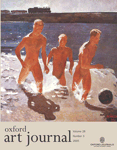-
Views
-
Cite
Cite
Paul Overy, Revising De Stijl, Oxford Art Journal, Volume 28, Issue 3, October 2005, Pages 491–495, https://doi.org/10.1093/oxartj/kci043
Close - Share Icon Share
Extract
Michael White: De Stijl and Dutch Modernism (Manchester University Press: Manchester, 2003), 176 pp., hardback ISBN 0-7190-6161-X, £49.99, paperback ISBN 0-719-6162-8, £15.99.
When the Rietveld Schröder House first opened to the public in 1987, visitors entered via the ground floor of the early twentieth-century brick, pitched-roofed terrace house next door which had been converted into a visitors' centre, passing through a door knocked between the two buildings. Today visitors begin their tour from one of a row of terraced houses opposite the Schröder House in the Erasmuslaan, designed as a speculative venture by Rietveld in collaboration with Truus Schröder in the early 1930s and recently restored as the new visitors' centre. From here they are guided to the Schröder House, passing under the motorway that has separated it from the Erasmuslaan since the mid-1960s.
Where the visit as originally configured implied a historicist progression from an unexceptional Dutch suburban house to a seminal modernist ‘icon’, the new configuration introduces the visitor first to a refined example of an international modernist terraced house and then proceeds to a detailed tour of the ‘ground-breaking’ Schröder House designed seven years earlier. This could be seen as a paradigm of the two different ways in which De Stijl has been represented since the early decades of the twentieth century: contextualised within a developmental history of Dutch modernism on the one hand, and showcased as a series of icons of an internationalising modernism on the other.



